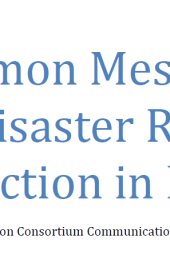Common Messages for Disaster Risk Reduction in Nepal
Summary
In order to ensure the public is receiving correct information on reducing risk and preparing for disaster, governments and organizations must agree to common messages. These common messages outline the technical content and correct advice for the public. The purpose of the common messages is to provide a technical framework of standardizing the substance of collective messages.
The NRRC Communications Group DRR Mapping exercise revealed that various organizations in Nepal are involved in communicating risk reduction to the public, but this communication has been ad-hoc, leading to varied messages. To avoid confusion among the public regarding disaster preparation and risk reduction, it is crucial for the government and organizations to agree on common messages. These common messages serve as a technical framework, ensuring standardized content and advice for the public. The goal is to enhance the effectiveness of communication efforts by providing consistent advice from all sources, which is more likely to be internalized by individuals. Stakeholder consultations have resulted in a comprehensive list of common messages for earthquake, flood, landslide, and fire. These messages cover three main categories: Awareness of Risk, Mitigation of Risk, and Preparedness for Response. While all messages are available, the emphasis is on communicating the 10 Key Messages to streamline and reinforce communication efforts. It is emphasized that the responsibility of the government and organizations is to customize the common messages to effectively reach their target audience. The common messages focus on providing technical and accurate information on risk reduction and disaster preparation, leaving the customization of how to communicate to the discretion of the government and organizations.
Categories:
Report
Publisher:
Nepal Risk Reduction Consortium Communications Group
Published Year:
2020
